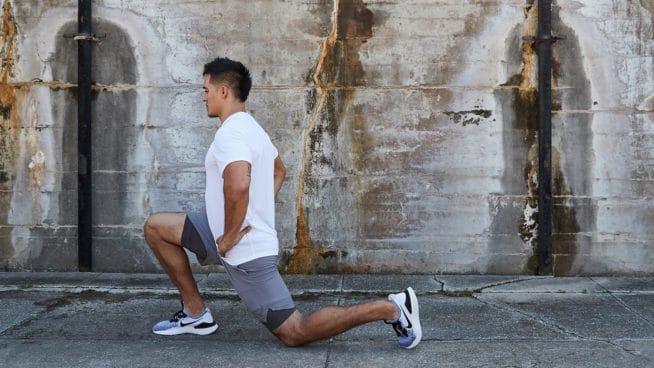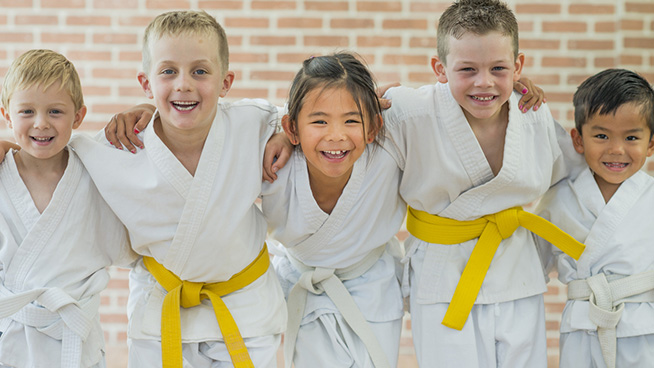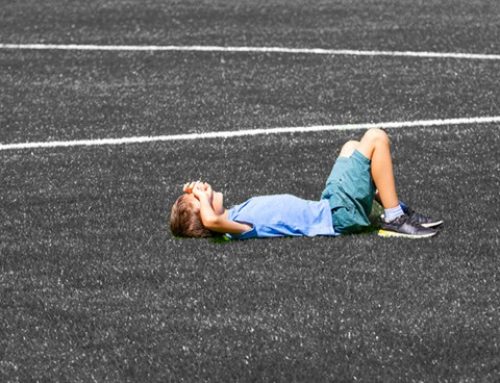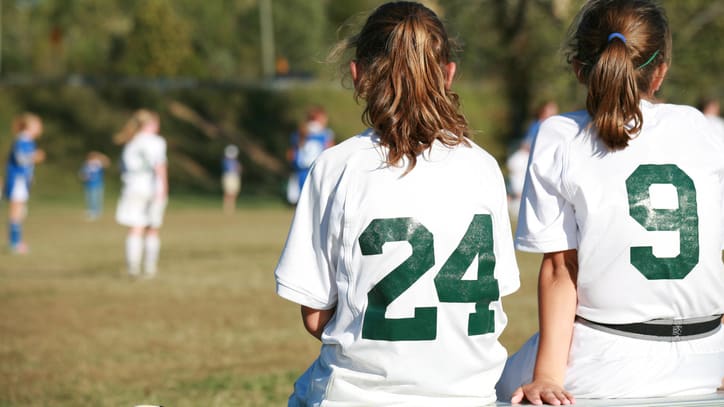Use This Hamstring Exercise to Prevent Knee Injuries and Pain
It can be an absolute monster to train through or around knee pain when you’re trying to increase lower-body strength and size. And because of knee pain, many lifters have to take time off from key lifts and movements such as Squats and Lunges.
But what if one exercise performed correctly and often could help you fix and prevent knee pain?
Well, there is such an exercise—Leg Curl variations that don’t involve a machine.
Benefits of Leg Curls
Non-machine Leg Curls can not only help you cure your painful knees and prevent future knee pain, but they can also add thickness to your hamstrings.
The goal is to target the hamstrings, because when you contract them together in proper fashion, the hamstrings help to stabilize the knee during compound movements such as Squats and Lunges, as well as prevent excessive anterior forces during knee extension. This is paramount when working to prevent knee pain and maximize lower-body movements.
And when it comes to forcing a muscle to grow, you must activate that muscle to a high capacity, create loads of tension and induce high amounts of metabolic stress. Non-machine Leg Curls and their variations do just that, because of the two main actions that are performed by the hamstrings.
The hamstrings both flex the knee and extend the hip. Non-machine Leg Curls maximize hamstring recruitment since both knee flexion and hip extension take place. With machine-based Leg Curls (either seated or prone) you are not required to actively extend your hip, resulting in less than maximal involvement of the hamstrings.
Leg Curl Variations
The key to each variation is that it must be executed properly to work without unwanted compensations. Each variation also has its unique demands and must be programmed appropriately to take full advantage.
The following variations are listed in order of difficulty. They are better suited for certain outcomes, from activation and blood flow, to create a greater hypertrophic environment.
Stability Ball Leg Curl
Yes, the stability ball.
High quality exercises can (and should) be performed with the stability ball. One of them is the Stability Ball Leg Curl.
Though it may look unimpressive, when you perform the exercise with purpose for 1-3 sets of 15-plus reps, it will help activate the hamstrings (and glutes). With greater hamstring activity, your knees will experience more stability and less pain.
Along with less pain, the hamstrings will also likely contribute more activation during subsequent movements. This will increase the amount of tension, metabolic stress and structural damage of the hamstrings, thereby enhancing the hypertrophic adaptations.
Finally, this variation provides stimulation without great fatigue, which allows you to perform at a high intensity during main movements that follow.
Key Points
- Engage your core to achieve and maintain a neutral pelvis and prevent unwanted anterior pelvic tilt throughout the exercise.
- Keep your hips bridged up throughout the movement to enhance hamstring activity, as the hamstrings work both to extend the hips and flex the knees.
- Drive your heels hard into the ball to maximize hamstring activity.
- Focus on keeping your toes pulled up toward your shins to prevent your calf muscles from performing too much work during knee flexion.
- Perform all reps with a slow and controlled tempo, the eccentric portion for 2-3 seconds, and hold the extended position for 1-3 seconds.
Single-Leg Stability Ball Leg Curl
With the single-leg version of the Stability Ball Leg Curl, you will create even more tension and metabolic stress through the hamstrings, as one extremity will be required to do the work that two were previously performing.
You will also be forced to control your hip stability to a greater degree, helping to enhance the control of your hips over your lower extremities, further solidifying a higher quality movement to prevent knee pain.
It will be more difficult to keep your hip bridged throughout the entire set, so this must be your prime focus. If your hips drop down, the activity of the hamstring decreases, because it’s no longer flexing your knee and extending your hips at the same time. So keep your hips up!
Like the Stability Ball Leg Curl, the single-leg version should not create an excessive amount of fatigue and can be performed in the beginning of a session for 1-3 sets of 10-15 reps per side. If you experience a high amount of fatigue, simply reduce the number of reps so you can complete the sets and achieve a solid blood flow and activation without fatigue.
[youtube video=”A1_AYGPH3DE” /]\Key Points
- Focus on preventing anterior tilt of the pelvis throughout, and keep your hips square toward the ceiling, preventing them from rotating.
- Continue to drive your heel hard into the ball and focus on keeping your hips up.
- Keep your arms out to the side to give you a better base to prevent rotation throughout the movement.
Slide Board Leg Curl
The Slide Board Leg Curl increases the challenge of the movement since you are now level with the ground and therefore have more of a gravitational influence. Because of this, you will experience greater tension through the hamstrings and a greater challenge to keep your pelvis from tilting anteriorly.
This variation is where the Leg Curl can be used for two different goals, depending on your training level.
If you are strong and have a well-developed posterior chain, the previous variations will likely become too easy to create the activation response you want without excessive repetitions. If this is the case, the slide board variation can be used as an activation and blood flow exercise to better prepare for upcoming lifts without inducing too much fatigue. Like the first two variations, you should program this for 1-3 sets of 10-15-plus reps.
If you are a beginner or intermediate lifter, you can add this variation as a higher rep assistance exercise designed to create a greater hypertrophic response. The greater tension and eccentric stress will create greater adaptations conducive to adding thickness to your hamstrings and preventing knee pain.
It would be best to program this variation after your main lifts for 2-4 sets of 10-20 reps. Here again, make sure to control the reps with a slow and deliberate tempo.
[youtube video=”HmK23FmWVaY” /]Key Points
- Maintain primary focus on keeping your hips neutral (not falling into anterior tilt) and not overextending your lower back in order to keep the work in the hamstrings.
- Perform the reps in a slow and controlled tempo with a 3- to 4-second eccentric and 1-2 second isometric.
- Drive your heels hard into the board to keep the tension through your hamstrings.
Slide Board Body Curl
Turning around and placing your body on the board increases the difficulty of the Leg Curl (now Body Curl) as you are now pulling more mass with each rep. This creates a greater need for increased force production from the hamstrings, thereby increasing the amount of overall tension.
This variation is where the breaking point occurs for the Leg Curl, going from an activation exercise to a highly effective assistance exercise. This variation can be performed once you have mastered the Slide Board Leg Curl and strengthened your hamstrings and glutes to a sufficient level.
Again, here you need to focus on keeping your hips from tipping anteriorly to maintain the contribution of the hamstrings and not the lower back.
Complete 2-4 sets of 8-15 reps after your main lifts. If you can easily complete 15+ reps, try holding a 25-pound plate on your chest for additional resistance.
[youtube video=”DZgQI0JJtwE” /]Key Points
- Like with the previous variations, emphasize preventing your hips from tipping anteriorly to keep your low back from falling into hyperextension and preventing your hamstrings from performing more work.
- Drive your heels hard into the ground to pull your body back toward your feet.
- Keep your hips and low back off the board throughout the movement to reduce the contact points on the board and keep the work in the glutes and hamstrings.
Single Leg Slide Board Leg Curl
Turn back around and place your feet on the slide board once again, only this time with one foot instead of two. This variation is a killer for the hamstrings, not only because you are asking one leg to perform the work of two, but because of the additional stability demand created by losing one of your contact points.
The greater stability demand creates an increased challenge and contraction of the hamstrings in order to stabilize the knee and hips.
This results in massive amounts of tension throughout the hamstrings and induces high levels of fatigue as well as hypertrophic adaptations.
This variation is best suited for the end of your lower-body training day as a finisher for the hamstrings. Perform 2-4 sets of 6-12 reps per side.
[youtube video=”wJVzrbwKw04″ /]Key Points
- Continue to focus on keeping your hip from tipping anteriorly, but now from rotating as well.
- Keep the knee of your working leg in line with your hip, not allowing it to rotate inward.
- Do not allow your hips to sink toward the floor during the transition back to the starting position.
- Keep a slow and controlled tempo using a 2- to 3-second eccentric and 1- to 2-second isometric.
Healthy Knees, Bigger Hamstrings
To fix and prevent knee pain, perform variations of the non-machine Leg Curl during every lower-body training session in order to activate your hamstrings and prepare for your main lifts. Add them to the end of your lower-body sessions to create thicker and stronger hamstrings.
One last thing: I apologize in advance if you find it difficult to walk the next day after implementing these variations into your program.
Photo Credit: Peopleimages/DigitalVision/Getty Images
READ MORE:
[cf]skyword_tracking_tag[/cf]RECOMMENDED FOR YOU
MOST POPULAR
Use This Hamstring Exercise to Prevent Knee Injuries and Pain
It can be an absolute monster to train through or around knee pain when you’re trying to increase lower-body strength and size. And because of knee pain, many lifters have to take time off from key lifts and movements such as Squats and Lunges.
But what if one exercise performed correctly and often could help you fix and prevent knee pain?
Well, there is such an exercise—Leg Curl variations that don’t involve a machine.
Benefits of Leg Curls
Non-machine Leg Curls can not only help you cure your painful knees and prevent future knee pain, but they can also add thickness to your hamstrings.
The goal is to target the hamstrings, because when you contract them together in proper fashion, the hamstrings help to stabilize the knee during compound movements such as Squats and Lunges, as well as prevent excessive anterior forces during knee extension. This is paramount when working to prevent knee pain and maximize lower-body movements.
And when it comes to forcing a muscle to grow, you must activate that muscle to a high capacity, create loads of tension and induce high amounts of metabolic stress. Non-machine Leg Curls and their variations do just that, because of the two main actions that are performed by the hamstrings.
The hamstrings both flex the knee and extend the hip. Non-machine Leg Curls maximize hamstring recruitment since both knee flexion and hip extension take place. With machine-based Leg Curls (either seated or prone) you are not required to actively extend your hip, resulting in less than maximal involvement of the hamstrings.
Leg Curl Variations
The key to each variation is that it must be executed properly to work without unwanted compensations. Each variation also has its unique demands and must be programmed appropriately to take full advantage.
The following variations are listed in order of difficulty. They are better suited for certain outcomes, from activation and blood flow, to create a greater hypertrophic environment.
Stability Ball Leg Curl
Yes, the stability ball.
High quality exercises can (and should) be performed with the stability ball. One of them is the Stability Ball Leg Curl.
Though it may look unimpressive, when you perform the exercise with purpose for 1-3 sets of 15-plus reps, it will help activate the hamstrings (and glutes). With greater hamstring activity, your knees will experience more stability and less pain.
Along with less pain, the hamstrings will also likely contribute more activation during subsequent movements. This will increase the amount of tension, metabolic stress and structural damage of the hamstrings, thereby enhancing the hypertrophic adaptations.
Finally, this variation provides stimulation without great fatigue, which allows you to perform at a high intensity during main movements that follow.
[youtube video=”-ef7diWc6jE” /]Key Points
- Engage your core to achieve and maintain a neutral pelvis and prevent unwanted anterior pelvic tilt throughout the exercise.
- Keep your hips bridged up throughout the movement to enhance hamstring activity, as the hamstrings work both to extend the hips and flex the knees.
- Drive your heels hard into the ball to maximize hamstring activity.
- Focus on keeping your toes pulled up toward your shins to prevent your calf muscles from performing too much work during knee flexion.
- Perform all reps with a slow and controlled tempo, the eccentric portion for 2-3 seconds, and hold the extended position for 1-3 seconds.
Single-Leg Stability Ball Leg Curl
With the single-leg version of the Stability Ball Leg Curl, you will create even more tension and metabolic stress through the hamstrings, as one extremity will be required to do the work that two were previously performing.
You will also be forced to control your hip stability to a greater degree, helping to enhance the control of your hips over your lower extremities, further solidifying a higher quality movement to prevent knee pain.
It will be more difficult to keep your hip bridged throughout the entire set, so this must be your prime focus. If your hips drop down, the activity of the hamstring decreases, because it’s no longer flexing your knee and extending your hips at the same time. So keep your hips up!
Like the Stability Ball Leg Curl, the single-leg version should not create an excessive amount of fatigue and can be performed in the beginning of a session for 1-3 sets of 10-15 reps per side. If you experience a high amount of fatigue, simply reduce the number of reps so you can complete the sets and achieve a solid blood flow and activation without fatigue.
[youtube video=”A1_AYGPH3DE” /]\Key Points
- Focus on preventing anterior tilt of the pelvis throughout, and keep your hips square toward the ceiling, preventing them from rotating.
- Continue to drive your heel hard into the ball and focus on keeping your hips up.
- Keep your arms out to the side to give you a better base to prevent rotation throughout the movement.
Slide Board Leg Curl
The Slide Board Leg Curl increases the challenge of the movement since you are now level with the ground and therefore have more of a gravitational influence. Because of this, you will experience greater tension through the hamstrings and a greater challenge to keep your pelvis from tilting anteriorly.
This variation is where the Leg Curl can be used for two different goals, depending on your training level.
If you are strong and have a well-developed posterior chain, the previous variations will likely become too easy to create the activation response you want without excessive repetitions. If this is the case, the slide board variation can be used as an activation and blood flow exercise to better prepare for upcoming lifts without inducing too much fatigue. Like the first two variations, you should program this for 1-3 sets of 10-15-plus reps.
If you are a beginner or intermediate lifter, you can add this variation as a higher rep assistance exercise designed to create a greater hypertrophic response. The greater tension and eccentric stress will create greater adaptations conducive to adding thickness to your hamstrings and preventing knee pain.
It would be best to program this variation after your main lifts for 2-4 sets of 10-20 reps. Here again, make sure to control the reps with a slow and deliberate tempo.
[youtube video=”HmK23FmWVaY” /]Key Points
- Maintain primary focus on keeping your hips neutral (not falling into anterior tilt) and not overextending your lower back in order to keep the work in the hamstrings.
- Perform the reps in a slow and controlled tempo with a 3- to 4-second eccentric and 1-2 second isometric.
- Drive your heels hard into the board to keep the tension through your hamstrings.
Slide Board Body Curl
Turning around and placing your body on the board increases the difficulty of the Leg Curl (now Body Curl) as you are now pulling more mass with each rep. This creates a greater need for increased force production from the hamstrings, thereby increasing the amount of overall tension.
This variation is where the breaking point occurs for the Leg Curl, going from an activation exercise to a highly effective assistance exercise. This variation can be performed once you have mastered the Slide Board Leg Curl and strengthened your hamstrings and glutes to a sufficient level.
Again, here you need to focus on keeping your hips from tipping anteriorly to maintain the contribution of the hamstrings and not the lower back.
Complete 2-4 sets of 8-15 reps after your main lifts. If you can easily complete 15+ reps, try holding a 25-pound plate on your chest for additional resistance.
[youtube video=”DZgQI0JJtwE” /]Key Points
- Like with the previous variations, emphasize preventing your hips from tipping anteriorly to keep your low back from falling into hyperextension and preventing your hamstrings from performing more work.
- Drive your heels hard into the ground to pull your body back toward your feet.
- Keep your hips and low back off the board throughout the movement to reduce the contact points on the board and keep the work in the glutes and hamstrings.
Single Leg Slide Board Leg Curl
Turn back around and place your feet on the slide board once again, only this time with one foot instead of two. This variation is a killer for the hamstrings, not only because you are asking one leg to perform the work of two, but because of the additional stability demand created by losing one of your contact points.
The greater stability demand creates an increased challenge and contraction of the hamstrings in order to stabilize the knee and hips.
This results in massive amounts of tension throughout the hamstrings and induces high levels of fatigue as well as hypertrophic adaptations.
This variation is best suited for the end of your lower-body training day as a finisher for the hamstrings. Perform 2-4 sets of 6-12 reps per side.
[youtube video=”wJVzrbwKw04″ /]Key Points
- Continue to focus on keeping your hip from tipping anteriorly, but now from rotating as well.
- Keep the knee of your working leg in line with your hip, not allowing it to rotate inward.
- Do not allow your hips to sink toward the floor during the transition back to the starting position.
- Keep a slow and controlled tempo using a 2- to 3-second eccentric and 1- to 2-second isometric.
Healthy Knees, Bigger Hamstrings
To fix and prevent knee pain, perform variations of the non-machine Leg Curl during every lower-body training session in order to activate your hamstrings and prepare for your main lifts. Add them to the end of your lower-body sessions to create thicker and stronger hamstrings.
One last thing: I apologize in advance if you find it difficult to walk the next day after implementing these variations into your program.
Photo Credit: Peopleimages/DigitalVision/Getty Images
READ MORE:
[cf]skyword_tracking_tag[/cf]










